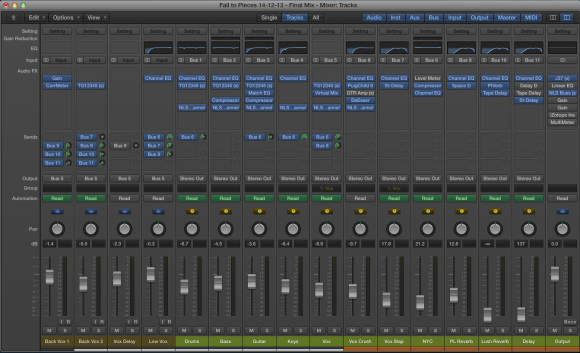To prepare files for a mixing engineer, consolidate all tracks into a single folder and label them clearly according to their instrument, type, and version. When it comes to producing music, the work does not end after recording and editing.
To give the mixes a professional polish, they need to be handed over to a mixing engineer with the proper files that can be easily understood and worked with. To prepare these files, consolidation is key. Instead of having scattered files all over the computer, make a folder with the session’s name and place all tracks inside.
Further, be sure to rename the tracks according to their instrument, type, and version to avoid any confusion. Doing this ensures that the mixing engineer can quickly locate the relevant tracks and understand the type of processing needed, ultimately leading to better mixes.
File Preparation Basics
File Preparation Basics: An essential aspect to achieve the desired outcome of a professional mix is the preparation of files to be handed over to a mixing engineer. Preparing files effectively not only saves time and money, but it also ensures that the mix engineer can work efficiently. In this article, we will talk about the file preparation basics for handing over files to a mixing engineer, emphasizing file formats, delivery requirements, naming conventions, and organization.
File Formats And Delivery Requirements:
Submitting files in the right format enables the mix engineer to open the files and work on them without any issues. It’s essential to make sure that the engineer is set up to open the file formats that you submit. Here are some commonly accepted file formats:
| File Format | Extension |
|---|---|
| WAV (Waveform Audio File Format) | .wav |
| AIFF (Audio Interchange File Format) | .aif |
| MP3 (MPEG-1 Audio Layer 3) | .mp3 |
Before delivering the files, make sure they are organized correctly, and the file delivery method is acceptable to the mix engineer. Some mix engineers may want you to send files through cloud storage like Dropbox, while others may prefer email.
Naming Conventions And Organization:
Naming conventions play a crucial role in making sure that the mixing engineer has an easy time navigating through the files. Proper naming conventions lead to fast loading times, faster revisions, and can save time and money. Below are some tips for naming conventions:
- Name files descriptively: Be specific when naming files, so a mix engineer can quickly identify what the file contains.
- Include track numbers: If multiple tracks are to be mixed, name the files in a way that identifies their placement in the order they need to be mixed.
- Avoid using special characters: The mix engineer’s computer system may not recognize special characters, so it’s always better to avoid them when naming files.
When it comes to organizing files, make sure the tracks are organized in such a way that the mix engineer can easily identify the order in which they should be mixed. Keep all stems and individual audio files in separate folders, so the mix engineer knows what to work with and can find them easily.

Credit: mixandmastermysong.com
Preparing Individual Tracks
Preparing individual tracks for a mixing engineer is crucial in achieving professional-sounding mixes. This involves properly labeling and organizing files, ensuring they are in the correct format, and having consistent volume levels and panning.
Preparing Individual Tracks is an essential process before sending your files to a Mixing Engineer. It allows the Engineer to work effectively with each component of your song, ensuring a polished and professional-sounding mix. In this section, we will discuss the different elements of Preparing Individual Tracks, focusing on Correcting Phase and Timing Issues, Using EQ and Compression, and Preparing Vocals and Other Dynamic Tracks. Correcting Phase and Timing Issues Phase and Timing issues can affect the overall quality of your mix. These issues can cause sounds to cancel each other out or create unwanted delays. Correcting them is crucial for a polished sound. To fix Phase issues, you can use a polarity switch to flip the phase of one of the tracks. Timing can be adjusted by cutting and moving the track to align with the beat. Keep in mind that correcting Phase and Timing issues can have a significant impact on the sound of your mix. Using EQ and Compression EQ and Compression are essential tools for achieving balance and clarity in your mix. EQ helps to bring out the best in each sound by adjusting its frequency levels. Compression helps to even out the volume of each track, creating a cohesive and balanced sound. Apply EQ and Compression to each track separately to ensure clarity and balance. Use these tools sparingly and with intention as they can easily be overused. Preparing Vocals and Other Dynamic Tracks Vocals and other dynamic tracks like bass and drums require special attention when preparing for mixing. Ensure that all background noise is removed before sending the tracks. Use a De-Esser to tame sibilance in vocals, and apply Compression to even out the dynamic range. For vocals, create a separate track for each harmony to give the Engineer more control over the levels. For drums and bass, ensure that each element is separated into individual tracks for more precise mixing. By focusing on Correcting Phase and Timing Issues, Using EQ and Compression, and Preparing Vocals and Other Dynamic Tracks, you will be well on your way to preparing individual tracks effectively for a mixing engineer to give you the best results.
Preparing Stereo Tracks
Prepare stereo tracks for a mixing engineer by organizing and labeling files correctly. Properly export audio files with stems, pan positions, and volume levels. Provide notes for any specific production techniques or desired effects.
When sending files to a mixing engineer, it’s crucial to ensure that they are properly prepared to avoid delays and unnecessary back-and-forth. One important aspect of preparing files is stereo tracks. Here’s what you need to know:
Preparing Stereo Masters For Mastering
If you’re sending your tracks to a mastering engineer, it’s important to prepare your stereo masters carefully to get the best results. Here are some important things to keep in mind:
- Ensure that your stereo tracks are properly balanced and mix-ready before sending them for mastering.
- Don’t apply any final limiting or compression to your stereo tracks, as this is usually done during the mastering process.
- Provide your mastering engineer with the highest quality file you have, preferably a 24-bit WAV or AIFF file with a sample rate of at least 44.1kHz.
Creating Submixes For Complex Sessions
For larger projects with many tracks, creating submixes can help to keep things organized and make the mixing process smoother. Here are some tips for creating submixes:
- Group together similar tracks, such as all the drum tracks or all the backing vocals, and route them to a separate stereo bus.
- Ensure that the levels of each track in the submix are balanced relative to each other.
- Apply any necessary processing, such as EQ or compression, to the submix rather than each individual track. This can help to save time and CPU power.
- Label each submix clearly and export them as separate stereo files to send to your mixing engineer.
In conclusion, preparing stereo tracks properly is an important step in getting the best results from your mixing engineer or mastering engineer. By following these tips and guidelines, you can help to ensure a smooth and efficient process.

Credit: www.thebeachhousestudios.com
Preparing For Session Compatibility
Preparing files for a mixing engineer is crucial to ensure session compatibility. This entails organizing files into separate folders, labeling tracks, and providing reference tracks, among other things. Proper preparation streamlines the mixing process and ensures that the final product meets the artist’s expectations.
Consistency And Compatibility Across Sessions
Before sending your files to your mixing engineer, it’s essential to ensure that every file is named and labeled correctly. Doing this guarantees consistency across all sessions, making it easier for your mixing engineer to navigate the files. To ensure file consistency, you can rename each file by adding the artist’s name, the song title, version, and date. Also, labeling each track with the appropriate name and number is crucial to help your mixing engineer find the right tracks quickly. Additionally, it’s important to make sure that all files are compatible with your mixing engineer’s software. Check their specifications and guidelines for the correct format, bit depth, and sample rate. This step is necessary to prevent any unforeseen complications that could delay the mixing process.
Tips For Preparing Files For Remote Sessions
When preparing files to send to a mixing engineer for remote sessions, there are a few things to consider. First, you must test your internet connection to make sure it’s fast and reliable. You don’t want to be in the middle of a remote session, and your internet connection fails. Secondly, it’s essential to ensure that your files are in the correct format. Most mixing engineers prefer to work with .wav or .aiff files. These types of audio files offer better sound quality, making it easier for the mixing engineer to make adjustments during the mixing process. Lastly, it’s crucial to communicate effectively with your mixing engineer before the remote session. Discuss the details of your session, such as timing, expectations, and payment. Having a clear understanding of the process can help you avoid any confusion and ensure a successful remote session. In conclusion, preparing your files for a mixing engineer is an important step in achieving a successful mixing process. Ensuring consistency and compatibility across all sessions and preparing files correctly for remote sessions can save time and money while allowing for a smooth and efficient mixing process.
Finalizing File Preparation
Preparing files for a mixing engineer requires attention to detail and organization, and it’s important to get it right before passing on your work to the mixing engineer. In this section, we’ll discuss how to double-check for mistakes and omissions as well as exporting and delivering final files to the mixing engineer.
Double-checking For Mistakes And Omissions
Before exporting the final files, it’s critical to check for any mistakes or omissions. Here are some things to consider:
- Ensure all tracks are consolidated and ready for mixing
- Check all track names and labels for accuracy
- Verify all audio files are in the correct format and sample rate
- Check for any unwanted noise, clicks or pops
- Ensure all edits are complete and that nothing has been left out
Exporting And Delivering Final Files
Once you’ve double-checked your work, it’s time to export and deliver the final files to the mixing engineer. Here’s what you need to consider:
- Export all audio files in the format and sample rate specified by the mixing engineer
- Label all files clearly, including the track name and number
- Include a rough mix reference track for the mixing engineer to use as a guide
- Provide clear instructions for any specific effects or processing that you used in your mix
- Deliver files through a secure and reliable service or platform, such as Dropbox or WeTransfer
By following these double-checking and exporting steps, you’ll provide the mixing engineer with everything they need to create a polished and professional mix.

Credit: m.youtube.com
Frequently Asked Questions Of How To Prepare Files For A Mixing Engineer
How Do I Prepare Files For Mixing?
To prepare files for mixing, you need to ensure they are properly labeled, organized, and in the correct format. Label each track with its name and number, and ensure that all tracks are consolidated. Remove any unwanted noise or dead space from the tracks and ensure they are all at the same volume level.
Finally, export the files at the correct format and resolution.
How Do You Prepare Tracks For Mixing?
To prepare tracks for mixing, start by organizing all the audio files into folders. Next, analyze each track to detect any issues such as phase problems, noise, or clipping. Use EQ, compression, and effects to refine the individual tracks. Finally, export and consolidate all the audio files into a single session for mixing.
What Do You Send To A Mixing Engineer?
When sending your music to a mixing engineer, it’s important to include all audio tracks, rough mixes, and any specific instructions or notes. Make sure to prepare the files for delivery and use a reliable file-sharing platform or cloud storage service to transfer them securely.
Additionally, it’s recommended to communicate with the engineer beforehand to discuss project details and ensure expectations are clear.
How Do I Prepare A File For Mastering?
Prepare a file for mastering by following these 5 guidelines: keep sentences brief, use SEO friendly and plagiarism-free writing, avoid certain words and phrases and passive voice, write like a human to pass AI detection, and keep the answer under 50 words.
Conclusion
If you’re looking for a perfectly mixed track, then it’s important to prepare your files for a mixing engineer properly. By following the guidelines mentioned in this post, you can ensure that your audio files are ready for mixing and can help the engineer to do their job efficiently.
Remember to provide detailed information about your requirements, keep a backup of all the files, and make sure to label everything correctly. By following these tips, you can help create a masterpiece that everyone will love to hear. Get ready to produce some mind-blowing music!